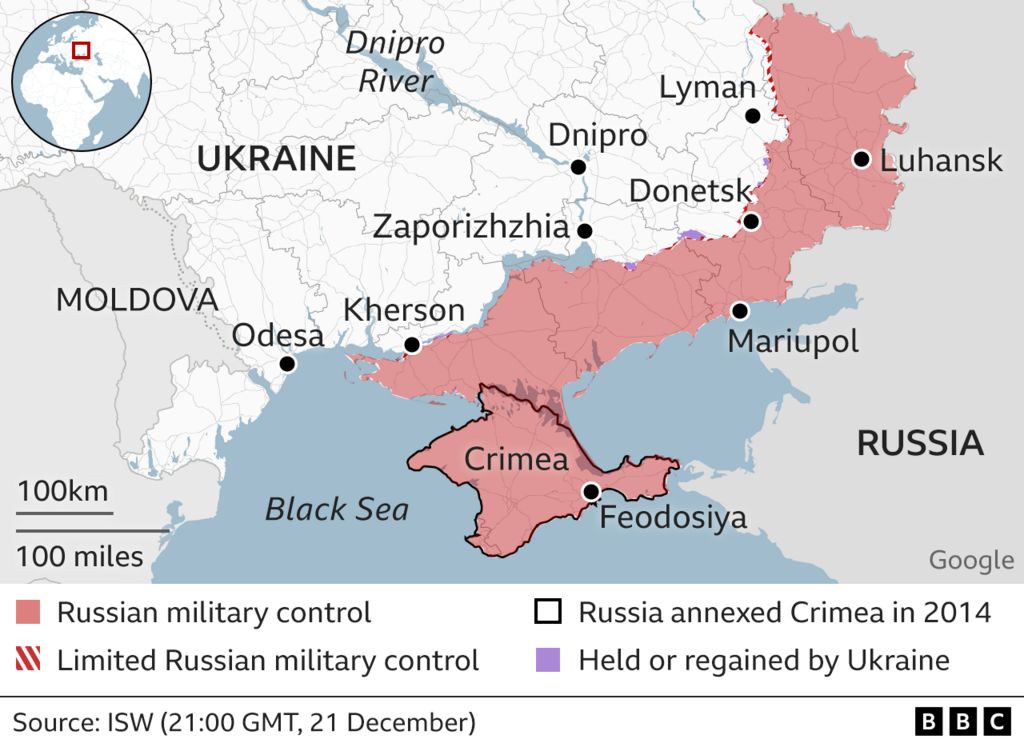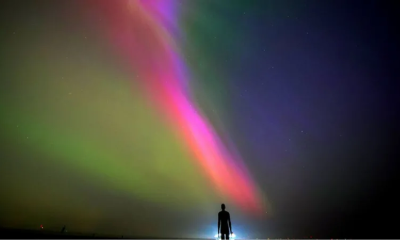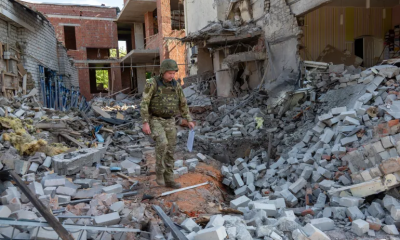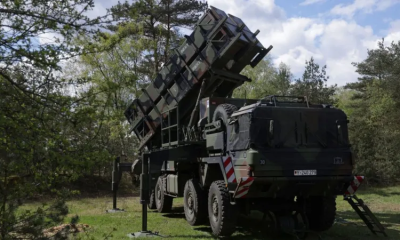Foreign News
Russia confirms damage to warship in Black Sea

Russia has confirmed one of its warships has been damaged in a Ukrainian attack on a Black Sea port.
The airstrike took place at Feodosiya in Russian-occupied Crimea early on Tuesday morning.
Russia’s Ministry of Defence said the large landing ship Novocherkassk was struck by Ukrainian aircraft carrying guided missiles. The head of the Ukrainian Air Force said earlier its warplanes had destroyed the ship.
One person was killed in the attack, according to the Russian-installed head of Crimea, Sergei Aksyonov. Several others were reportedly hurt. Six buildings were damaged and a small number of people had to be taken to temporary accommodation centres, Aksyonov added.
The port’s transport operations are said to be functioning as normal after the area was cordoned off, while a fire caused by the attack was contained.
Footage purportedly showing a huge explosion in the port was shared by Ukrainian air force commander Lt Gen Mykola Oleshchuk.
The images have not been independently verified. However, satellite imagery from 24 December shows a ship at port in Feodosiya that appears to be the same length as the Novocherkassk – a landing ship designed to transport troops, weapons and cargo to shore.
Any significant damage to the ship will be a welcome bit of good news for Ukraine, with waning Western support now affecting its front-line operations. Given that the Novocherkassk was in dock, it is highly likely it was being loaded with soldiers, equipment or both.
Taking it out of action, even if only temporarily, will no doubt hamper Russia’s ability to supply troops in territory it occupies further north. What is less clear is how long its operations will be disrupted for and what impact this strike will have on the front lines.
Meanwhile, a spokesman for Ukraine’s air force has denied that Russia shot down two of its Su-24 bombers about 125km (77 miles) from the occupied Ukrainian city of Mykolaiv. It has also recently denied a claim by Russian Defence Minister Sergei Shoigu that his troops have seized the key town of Mariinka in eastern Ukraine.
The area has been used by Ukraine as a defensive barrier since 2014, when Russian-backed fighters seized large swathes of the Donetsk and Luhansk regions.
Tuesday’s attack on Feodosiya is not the first time that the Novocherkassk has been targeted by Ukrainian forces.
In March 2022, Ukraine’s defence ministry reported that the ship had been damaged in an attack on the occupied Ukrainian port of Berdyansk in which another amphibious assault ship, the Saratov, was sunk.
In a post on Telegram, Lt Gen Oleshchuk wrote that the Novocherkassk had gone the way of the Moskva – the flagship of Russia’s Black Sea Fleet, which sank in the Black Sea last year.
Ukrainian President Volodymyr Zelensky quipped that he was “grateful” to the country’s air force “for the impressive replenishment of the Russian submarine Black Sea fleet with another vessel,” in reference to other Russian ships that have been sunk during the war.
“The occupiers will not have a single peaceful place in Ukraine,” he said.
Russia seized and annexed the Crimean Peninsula from Ukraine in 2014 and its forces based there played a key part in the full-scale invasion of Ukraine in February 2022. Russian forces in Crimea have since come under repeated Ukrainian attack. Last month, Ukraine’s military said it had destroyed 15 Russian navy ships and damaged another 12 in the Black Sea since the start of Russia’s war.
After a missile strike on the headquarters of the Black Sea fleet in Sevastopol last September, satellite images showed that the Russian navy had moved much of its Black Sea fleet away from Crimea to the Russian Black Sea port of Novorossiysk.
The dominance of the Russian navy has been diminished to an extent as result of such attacks, but this year has seen Moscow keep hold of the territory it occupies, despite a Ukrainian counteroffensive.

((BBC)
Foreign News
Nasa ‘Earthrise’ astronaut dies at 90 in plane crash

Apollo 8 astronaut Bill Anders, who snapped one of the most famous photographs taken in outer space, has died at the age of 90.
Officials say a small plane he was flying crashed into the water north of Seattle, Washington.
Anders’ son Greg confirmed that his father was flying the small plane, and that his body was recovered on Friday afternoon. “The family is devastated. He was a great pilot. He will be missed,” a statement from the family reads.
Anders – who was a lunar module pilot on the Apollo 8 mission – took the iconic Earthrise photograph, one of the most memorable and inspirational images of Earth from space.
Taken on Christmas Eve during the 1968 mission, the first crewed space flight to leave Earth and reach the Moon, the picture shows the planet rising above the horizon from the barren lunar surface.
Anders later described it as his most significant contribution to the space programme.

The image is widely credited with motivating the global environmental movement and leading to the creation of Earth Day, an annual event to promote activism and awareness of caring for the planet.
Speaking of the moment, Anders said: “We came all this way to explore the Moon, and the most important thing that we discovered was the Earth.”
Officials said on Friday that Anders crashed his plane around 11:40PDT (1940BST).
The US National Transportation Safety Board (NTSB) said the 90-year-old was flying a Beechcraft A A 45 – also known as a T-34. The agency said that the plane crashed about 80ft (25m) from the coast of Jones Island.
Anders also served as the backup pilot to the Apollo 11 mission, the name of the effort that led to the first Moon landing on July 24, 1969.
Following Anders’ retirement from the space programme in 1969, the former astronaut largely worked in the aerospace industry for several decades. He also served as US Ambassador to Norway for a year in the 1970s.
But he is best remembered for the Apollo 8 mission and the iconic photograph he took from space.
“In 1968, during Apollo 8, Bill Anders offered to humanity among the deepest of gifts an astronaut can give. He traveled to the threshold of the Moon and helped all of us see something else: ourselves,” Nasa Administrator Bill Nelson said in a statement.
Mark Kelly, a former astronaut who now serves as a US Senator for the state of Arizona, said in a post on X, formerly Twitter, that Anders “inspired me and generations of astronauts and explorers. My thoughts are with his family and friends”.
[BBC]
Foreign News
China’s Chang’e-6 lifts off from far side of Moon with rock samples

A Chinese spacecraft carrying rock and soil samples from the far side of the Moon has lifted off from the lunar surface to start its journey back to Earth, according to state media.
The achievement on Tuesday is a world first and the latest leap for Beijing’s decades-old space programme, which aims to send a crewed mission to the Moon by 2030.
The Xinhua News Agency, citing the China National Space Administration (CNSA), said that the ascender of the Chang’e-6 probe took off at 7:38am local time on Tuesday (23:38 GMT) and entered a preset orbit around the moon.
It described the move as “an unprecedented feat in human lunar exploration history”.
The Chang’e-6 probe was launched last month and its lander touched down on the far side of the Moon on Sunday. It used a drill and robotic arm to dig up soil on and below the Moon’s surface, according to Xinhua.
After successfully gathering its samples, the Chang’e-6 unfurled China’s national flag for the first time on the far side of the Moon, it said.
The agency cited the CNSA as saying that the spacecraft stowed the samples it had gathered in a container inside the ascender of the probe as planned.
[Aljazeera]
Foreign News
China says its spacecraft lands on Moon’s far side

China says its uncrewed craft has successfully landed on the far side of the Moon – an unexplored place almost no-one tries to go.
The Chang’e 6 touched down in the South Pole-Aitken Basin at 06:23 Beijing time on Sunday morning (22:23 GMT Saturday), the China National Space Administration (CNSA) said.
Launched on 3 May, the mission aims to collect precious rock and soil from this region for the first time in history. The probe could extract some of the Moon’s oldest rocks from a huge crater on its South Pole.
The landing was fraught with risks, because it is very difficult to communicate with spacecraft once they reach the far side of the Moon. China is the only country to have achieved the feat before, landing its Chang’e-4 in 2019.
After launching from Wenchang Space Launch Center, the Chang’e 6 spacecraft had been orbiting the Moon waiting to land. The lander component of the mission then separated from the orbiter to touch down on the side of the Moon that faces permanently away from Earth.
During the descent, an autonomous visual obstacle avoidance system was used to automatically detect obstacles, with a visible light camera selecting a comparatively safe landing area based on the brightness and darkness of the lunar surface, the CNSA was quoted as saying by state-run Xinhua news agency.
The lander hovered about 100m (328ft) above the safe landing area, and used a laser 3D scanner before a slow vertical descent. The operation was supported by the Queqiao-2 relay satellite, the CNSA said.
Chinese state media described the successful landing as an “historic moment”. The state broadcaster said “applause erupted at the Beijing Aerospace Flight Control Center” when the Chang’e landing craft touched down on the Moon early on Sunday morning.
The lander should spend up to three days gathering materials from the surface in an operation the CNSA said would involve “many engineering innovations, high risks and great difficulty”. “Everyone is very excited that we might get a look at these rocks no-one has ever seen before,” explains Professor John Pernet-Fisher, who specialises in lunar geology at the University of Manchester.
He has analysed other lunar rock brought back on the American Apollo mission and previous Chinese missions. But he says the chance to analyse rock from a completely different area of the Moon could answer fundamental questions about how planets form.
Most of the rocks collected so far are volcanic, similar to what we might find in Iceland or Hawaii. But the material on the far side would have a different chemistry . “It would help us answer those really big questions, like how are planets formed, why do crusts form, what is the origin of water in the solar system?” the professor says.
The mission aims to collect about 2kg (4.4lb) of material using a drill and mechanical arm, according to the CNSA.
The South Pole–Aitken basin, an impact crater, is one of the largest known in the solar system.
From there, the probe could gather material that came from deep inside the lunar mantle – the inner core of the Moon – Prof Pernet-Fisher says.
The Moon’s South Pole is the next frontier in lunar missions – countries are keen to understand the region because there is a good chance it has ice.

The capsule in the last Chinese moon mission, Chang’e 5, brought back soil and rocks in 2020 (BBC)
Access to water would significantly boost the chances of successfully establishing a human base on the Moon for scientific research.
If the mission succeeds, the craft will return to Earth with the precious samples on board a special return capsule.
The material will be kept in special conditions to try to keep it as pristine as possible.
Scientists in China will be given the first chance to analyse the rocks, and later researchers around the world will be able to apply for the opportunity too.
This is the second time China has launched a mission to collect samples from the Moon.
In 2020 Chang’e 5 brought back 1.7kg of material from an area called Oceanus Procellarum on the Moon’s near side.
China is planning three more uncrewed missions this decade as it looks for water on the Moon and investigates setting up a permanent base there.
Beijing’s broader strategy aims to see a Chinese astronaut walk on the moon by around 2030.
The US also aims to put astronauts back on the moon, with Nasa aiming to launch its Artemis 3 mission in 2026.
(BBC)
























